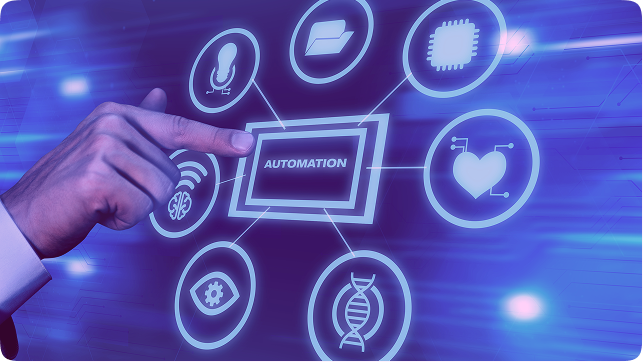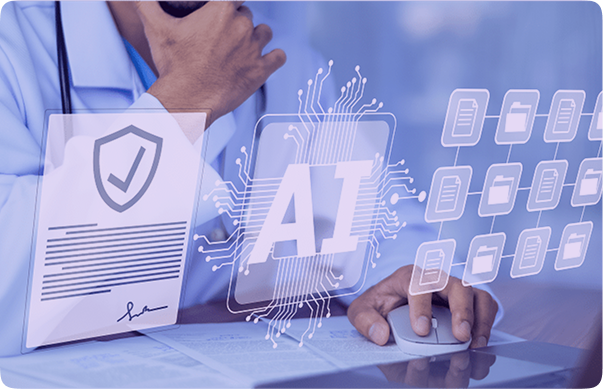Introduction
Processing Explanation of Benefits (EOB) documents shouldn’t feel like navigating a maze. Yet for many healthcare providers, manual verification, inconsistent payer formats, and outdated systems make it exactly that—slow, error-prone, and costly. The complexity of unstructured data and payer-specific variations often stalls efficiency, delaying reimbursement and missed financial insights.
Now imagine an ecosystem where claims data is not just captured but understood. That’s the promise of AI in modern revenue cycle management. By moving beyond basic automation toward pattern recognition and contextual understanding, AI transforms EOB processing into an intelligent, data-driven workflow—streamlining accuracy, reducing manual effort, and unlocking real-time insights that drive smarter, faster financial decisions.

The Strategic Role of AI in Modern Revenue Cycle Management
The role of artificial intelligence (AI) in revenue cycle management goes far beyond routine automation. Traditional systems rely on rigid templates and rule-based extraction that captures data without understanding it. AI, on the other hand, recognizes patterns, interprets context, and derives meaning from complex EOB data—turning raw inputs into actionable intelligence.
- From automation to intelligence: AI replaces repetitive manual tasks with context-aware automation, allowing healthcare organizations to work smarter, not harder.
- Minimizing revenue leakage: Through predictive modelling and real-time data validation, AI identifies claim errors early, reduces denials, accelerates reimbursements, and enhances the overall financial health of hospitals and their billing teams.
- Beyond legacy extraction: Unlike legacy OCR tools that simply read documents, intelligent EOB processing continuously learns from each cycle. It identifies payer behaviours, decodes denial patterns, and predicts claim outcomes with increasing accuracy.
Each processed EOB enhances the system’s understanding, resulting in faster posting, fewer corrections, and greater financial transparency. For healthcare, adopting AI-powered EOB automation isn’t just a tech upgrade — it’s a strategic shift toward sustainable, data-driven growth.
Core Challenges in EOB Data Processing
EOB management is fraught with complexities due to diverse payer formats, legacy infrastructure, and compliance requirements. These barriers often delay reimbursements and weaken revenue integrity.
- Fragmented Payer Formats: Each payer follows its own data structure and layout. With no standardized format, automation tools struggle to interpret fields correctly, leading to slower processing and delayed reimbursements.
- Poor-Quality Inputs: Many EOBs arrive as scanned or faxed PDFs. These low-resolution files often distort numbers and text, making accurate OCR (Optical Character Recognition) extraction a challenge.
- Multi-Line and Multi-Patient Complexity: EOBs covering multiple patients or procedures require detailed line-by-line reconciliation. Without intelligent parsing, manual errors in payment and patient mapping are inevitable.
- Legacy Integration Barriers: Older hospital systems rarely integrate smoothly with modern automation tools. This creates data silos, hinders interoperability, and limits scalability.
- Compliance and Security Pressures: Processing EOBs involves Protected Health Information (PHI). Even minor lapses in data handling can trigger compliance risks under HIPAA and other healthcare regulations.
- Dependence on Human Oversight: Despite automation advances, human validation remains essential for edge cases, exceptions, and ambiguous data.
By addressing these EOB data processing challenges through AI-driven document extraction, intelligent validation, and secure automation, healthcare organizations can reduce manual workloads, boost accuracy, and accelerate revenue cycles; thus, building a more efficient, compliant, and data-driven future.

AI-Powered Solution Framework: Turning EOB Complexity into Scalable Automation
Addressing EOB complexities requires more than surface-level automation—it demands intelligence that understands structure, adapts to change, and scales with organizational needs. AI-powered solution framework delivers a smarter, secure, and future-ready approach to healthcare data automation.
Smarter Learning, Greater Accuracy
At the core of this framework are layout-agnostic machine learning models trained on diverse, multi-payer EOB datasets. These models recognize text, patterns, and contextual nuances, regardless of layout or file type.
By automating extraction, classification, and structured field mapping, the system eliminates repetitive manual work and ensures high accuracy from day one. The result is faster posting, fewer errors, and stronger financial precision.
Human Expertise Meets Machine Intelligence
AI doesn’t replace people, it empowers them. Through human-in-the-loop verification, every exception becomes an opportunity for learning and refinement. Each verified case strengthens the model accuracy, combining automation speed with human judgment.
This hybrid intelligence reduces claim denials, accelerates reimbursements, and ensures a smoother revenue cycle workflow.
Security and Compliance by Design
Built with a compliance-first architecture, the framework safeguards every data point through encryption, access governance, and detailed audit logs. The platform aligns fully with HIPAA and PHI protection standards, ensuring that automation never compromises security.
Seamless Integration and Scalability
Designed for interoperability, the solution integrates seamlessly with existing EHR, RCM, and billing systems through secure APIs and RPA connectors. This enables real time data exchange and effortless scalability, helping healthcare organizations modernize operations without workflow disruption.
Ultimately, iCaptur’s AI-powered EOB framework transforms manual, error-prone revenue cycle processes into a scalable ecosystem of intelligent automation—driving financial clarity, faster reimbursements, and measurable business growth.
High-Impact Functional Use Cases
From Automation to Intelligent Action, AI-powered EOB automation is transforming the way healthcare organizations manage revenue operations. It’s not just a technological shift—it’s a strategic enabler that turns every Explanation of Benefits into actionable intelligence.
Automated Extraction and Classification
Automated claim-level and line-item extraction ensure every billed amount, remark code, and payment adjustment is accurately captured and categorized. This eliminates repetitive data entry and minimizes posting errors while offering full visibility into claim performance.
AI-Driven Denial Code Intelligence
Beyond basic extraction, AI detects and interprets denial codes to uncover root causes, spot recurring patterns, and recommend corrective actions. This gives revenue teams deep visibility into payer behavior, preventing revenue leakage and accelerating reimbursement turnaround.
Batch Processing and Real-Time Validation
Built for scale, the platform supports batch processing of large or consolidated EOB files without compromising accuracy. Integrated real-time validation flags inconsistencies before posting, minimizing downstream errors and ensuring clean, reliable data across systems.
Actionable Insights and Standardized Reporting
Extracted data is automatically standardized and integrated into dashboards, providing clear visibility into denial trends, cash flow, and payer performance. Decision-makers can easily monitor metrics, identify bottlenecks, and drive continuous improvement.

Business and Operational Outcomes: Turning Automation into Measurable Impact
Implementing AI-powered EOB automation delivers measurable results that enhance efficiency, accuracy, and profitability across the revenue cycle. By digitizing and standardizing manual processes, healthcare providers can build faster, smarter, and more compliant revenue operations.
Key Outcomes of Intelligent EOB Automation
- Significant Reduction in Manual Workload: Automating claim posting and data validation drastically cuts processing time and administrative effort, freeing staff to focus on strategic tasks.
- Improved Accuracy and Faster Reimbursements: With AI eliminating human errors and accelerating data capture, organizations experience shorter reimbursement cycles and stronger payer relationships.
- Lower Denial Rates and Quicker Appeals: Predictive analytics detect recurring denial trends, helping teams resolve issues proactively and improve appeal turnaround.
- Enhanced Compliance and Data Security: Built-in audit trails and automated validation controls ensure adherence to HIPAA and regulatory standards, reducing compliance risk.
- Real-Time Visibility and Better Decisions: Centralized dashboards provide instant insights into revenue performance, claim trends, and cash flow for smarter, data-driven decision-making.
Deployment & Scalability Considerations
Implementing AI-driven automation in healthcare requires flexibility, interoperability, and performance that scales with business needs. iCaptur’s automation framework is designed to adapt to each organization’s unique infrastructure while maintaining security, performance, and compliance.
- Flexible Deployment Models: Choose from cloud, on-premises, or hybrid architectures to align with infrastructure and compliance goals. Each model delivers high performance, security, and operational efficiency.
- Seamless System Integration: Designed for easy connection with existing EHR, RCM, and billing systems through secure APIs and RPA connectors, enabling faster implementation and minimal workflow disruption.
- Enterprise-Level Scalability: Built to manage large-scale claim and EOB volumes with consistent speed and accuracy, ensuring reliable performance even in high-demand environments.
- Structured Change Management: Intuitive workflows and guided adoption strategies help teams transition smoothly, driving higher productivity and faster ROI.
- Continuous AI Learning: Machine learning models evolve with real-world data, enhancing precision, adaptability, and predictive capability over time.
Together, these capabilities ensure a future-ready revenue cycle ecosystem — one that grows smarter, faster, and more resilient with every claim processed.
Conclusion
AI is redefining the future of EOB processing by turning manual, data-heavy tasks into a strategic revenue optimization system. By leveraging automation, machine learning, and intelligent analytics, healthcare organizations can achieve higher accuracy, faster reimbursements, and measurable efficiency gains. This shift not only improves financial transparency but also empowers teams to focus on decision-making rather than data handling.
The next phase of innovation lies in autonomous revenue cycles and predictive reimbursement models, where AI continuously learns from real-world data. As automation evolves into intelligence, healthcare enterprises will move toward smarter, proactive revenue management that drives long-term financial sustainability.
Ready to unlock the full potential of your healthcare data? Connect with us to digitize and modernize decades of structured and unstructured EOBs, streamline claim processing, and seamlessly integrate automation across your revenue systems for a smarter, faster, and more connected future.
Enhancing your workflow through
AI integration is key to future success.
processes and improve efficiency!
I architect and build advanced technology platforms and AI products that drive efficiency, innovation, and smarter workflows. As Co-Founder and CTO at iTech, I lead technology strategy, product development, and innovation across healthcare, energy, A&E, and manufacturing—delivering robust solutions that power 200+ clients and 100+ global businesses.





